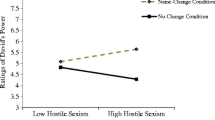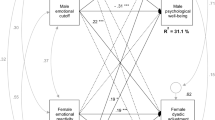Abstract
The purpose of the present study was to examine the amount and type of interrole conflict experienced by women and men at different life stages. A battery of questionnaires, including a demographic questionnaire, a role conflict scale, and the Bern Sex Role Inventory was administered to 244 married adults. The sample was primarily Caucasian. Overall, the impact of life stage, gender, and gender-related personality factors on interrole conflict was differentially influenced by the type of conflict assessed. Both women and men experienced the highest amount of conflict involving parent roles during the peak child-rearing years. In addition, employed men experienced a higher degree of interrole conflict between professional versus self roles than employed women. Married men experienced more spouse versus self role conflict than married women. Finally, instrumentality and interpersonal sensitivity proved to be two important predictors of interrole conflict above and beyond life stage and gender effects. Results are discussed in the context of societal changes towards traditional women and men's roles.
Similar content being viewed by others
REFERENCES
Aryee, S. (1992). Antecedents and outcomes of work-family conflict among married professional women: Evidence from Singapore. Human Relations, 45, 813-837.
Ashmore, R. D. (1990). Sex, gender, and the individual. In L. A. Pervin (Ed.), Handbook of personality: Theory and research (pp. 486-526). New York: Guilford Press.
Barnett, R. C., & Marshall, N. L. (1991). The relationship between women's work and family roles and subjective well-being and psychological distress. In M. Frankenhaeuser, U. Lundberg, & M. Chesney (Eds.), Women, work and health: Stress and opportunities (pp. 111-136). New York: Plenum.
Barnett, R. C., Marshall, N. L., & Pleck, J. H. (1992).Men's multiple roles and their relationship to men's psychological distress. Journal of Marriage and the Family, 54, 358-367.
Bem, S. L. (1974). The measurement of psychological androgyny. Journal of Consulting and Clinical Psychology, 42, 155-162.
Bialeschki, M. D., & Michener, S. (1994). Re-entering leisure: Transition within the role of motherhood. Journal of Leisure Research, 24, 57-74.
Blanchard-Fields, F., Suhrer-Roussel, L., & Hertzog, C. (1994). A confirmatory factor analysis of the Bem Sex Role Inventory: Old questions, new answers. Sex Roles, 30, 423-458.
Brok, A. J. (1992). Crises and transitions: Gender and life stage issues in individual, group, and couples treatment. Psychoanalysis and Psychotherapy, 10, 3-16.
Burley, K. A. (1994). Gender differences and similarities in coping responses to anticipated work-family conflict. Psychological Reports, 74, 115-123.
Bursik, K. (1995). Gender-related personality traits and ego development: Differential patterns for men and women. Sex Roles, 32, 601-616.
Christensen, K. E., & Staines, G. L. (1990). Flextime: A viable solution to work/family conflict? Special Issue: The impact of workplace family policies. Journal of Family Issues, 11, 455-476.
Cournoyer, R. J., & Mahalik, J. R. (1995). Cross-sectional study of gender role conflict examining college-aged and middle-aged men. Journal of Counseling Psychology, 42, 11-19.
Crosby, F. J. (1987). Spouse, parent, worker: On gender and multiple roles. New Haven and London: Yale University Press.
Dederick, J. G., & Miller, H. L. (1992). Transitions in adulthood: Are they the same for women and for men? In B. R. Wainrib (Ed.), Gender issues across the life cycle (pp. 44-55). New York: Springer Publishing Co.
Denmark, F. L. (1992). The thirty-something women: To career or not to career. In B. R. Wainrib (Ed.), Gender issues across the life cycle (pp. 71-76). New York: Springer Publishing Co.
Duxbury, L. E., & Higgins, C. A. (1991). Gender differences in work-family conflict. Journal of Applied Psychology, 76, 60-73.
Duxbury, L. E., Higgins, C. A., & Lee, C. (1994). Work-family conflict: A comparison by gender, family type, and perceived control. Journal of Family Issues, 15, 449-466.
Epstein, C. F. (1987). Multiple demands and multiple roles: The conditions of successful management. In F. J. Crosby (Ed.), Spouse, parent, worker: On gender and multiple roles (pp. 23-35). New Haven and London: Yale University Press.
Erera, I. P. (1991). Role conflict among public welfare supervisors. Administration in Social Work, 15, 35-51.
Feldman, S. S., & Aschenbrenner, B. (1983). Impact of parenthood on various aspects of masculinity and femininity: A short-term longitudinal study. Developmental Psychology, 19, 278-289.
Feldman, S. S., Biringen Z. C., & Nash, S. C. (1981). Fluctuations of sex-related self-attributions as a function of stage of family life cycle. Developmental Psychology, 17, 24-35.
Frone, M. R., Russell, M., & Cooper, M. L. (1992). Prevalence of work-family conflict: Are work and family boundaries asymmetrically permeable? Journal of Organizational Behavior, 13, 723-729.
Gilbert, L. A. (1988). Sharing it all: the rewards and struggles of two-career families. New York: Plenum.
Greenglass, E. R. (1991). Burnout and gender: Theoretical and organizational implications. Canadian Psychology, 32, 562-574.
Greenhaus, J. H. (1988). The intersection of work and family roles: Individual, interpersonal and organizational issues. In E. B. Goldsmith (Ed.), Work and family theory, research, and applications (pp. 23-45). Newbury Park, CA: Sage.
Guelzow, M. G., Bird, G. W., & Koball, E. H. (1991). An exploratory path analysis of the stress process for dual-career men and women. Journal of Marriage and the Family, 53, 151-164.
Gunter, N. C., & Gunter, B. G. (1990). Domestic division of labor among working couples: Does androgyny make a difference? Psychology of Women Quarterly, 14, 355-370.
Guttman, D. (1987). Reclaiming powers: Towards a psychology of later life. New York: Basic Books.
Havighurst, R. J. (1976). Developmental tasks and education. New York: McKay.
Hansen, L. B., & Jacob, E. (1992). Intergenerational support during the transition to parenthood: Issues for new parents and grandparents. Families in Society, 73, 471-479.
Heppner, P. P. (1995). On gender role conflict in men: Future direction and implication for counseling. Journal of Counseling Psychology, 42, 20-23.
Hochschild, A., & Machung, A. (1989). The second shift. New York: Viking.
Holahan, C. K., & Gilbert, L. A. (1979). Interrole conflict for working women: Career versus jobs. Journal of Applied Psychology, 64, 86-90.
Hughes, D., & Galinsky, E. (1994). Gender, Job, and family conditions, and psychological symptoms, Psychology of Women Quarterly, 18, 251-270.
Izraeli, D. N. (1993). Working/family conflict among men and women managers in dual career couples in Israel. Journal of Social Behavior and Personality, 8, 371-385.
Joshi, A., & Sastry, N. (1995). Work and family: Conflict and its resolution. Indian Journal of Gender Studies, 2, 227-241.
Kramer, D. A., & Melchior, J. (1990). Gender, role conflict, and the development of relativistic and dialectical thinking. Sex Roles, 23, 553-575.
Lai, G. (1995). Work and family roles and psychological well-being in Urban China. Journal of Health and Social Behavior, 36, 11-37.
Livingston, M. M., & Burley, K. A. (1991). Surprising initial findings regarding sex, sex role, and anticipated work-family conflict. Psychological Reports, 68, 735-738.
Lopata, H. Z. (1994). Circles and settings: Role changes of American women. New York: State University of New York Press.
Marsh, H. W., & Myers, M. (1986). Masculinity, femininity, and androgyny: A methodological and theoretical critique. Sex Roles, 14, 397-430.
Moore, D. (1995). Role conflict: Not only for women? A comparative analysis of 5 nations. International Journal of Comparative Sociology, 36, 17-35.
Moore, D., & Gobi, A. (1995). Role conflict and perceptions of gender roles (The case of Israel). Sex Roles, 32, 251-270.
Napholz, L. (1995). Mental health and American Indian women's multiple roles. American Indian and Alaska Native Mental Health Research, 6, 57-75.
Nieva, V. (1988). Work and family linkages. In L. Larwood, A. Stromberg, & B. Gutek (Eds.), Women and work (Vol. 3). Newbury Park, CA: Sage.
Ozer, E. M. (1995). The impact of children responsibility and self-efficacy on the psychological health of professional working mothers. Psychology of Women Quarterly, 19, 315-335.
Reifman, A., Biernat, M., & Lang, E. L. (1991). Stress, social support, and health in married professional women with small children, Psychology of Women Quarterly, 15, 431-445.
Rushing, B., & Schwabe, A. (1995). The health effects of work and family role characteristics: Gender and race comparisons. Sex Roles, 33, 59-76.
Settersten, R. A., & Hagestad, G. O. (1996). What's the latest? Cultural age deadlines for family transition. The Gerontologist, 36, 178-188.
Sharpe, M. J., & Heppner, P. P. (1991). Gender role, gender-role conflict, and psychological well-being in men. Journal of Counseling Psychology, 38, 323-330.
Sharpe, M. J., Heppner, P. P., & Dixon, W. A. (1995). Gender role conflict, instrumentality, expressiveness, and well-being in adult men. Sex Roles, 33, 1-18.
Shaw, E., & Burns, A. (1993). Guilt and the working parent. Australian Journal of Marriage and Family, 14, 30-43.
Shifren, K., Bauserman, R., & Carter, D. B. (1993). Gender role orientation and physical health: A study among young adults. Sex Roles, 29, 421-432.
Simon, R. W. (1995). Gender, multiple roles, role meaning, and mental health. Journal of Health and Social Behavior, 36, 182-194.
Stephens, M. A. P., Franks, M. M., & Townsend, A. L. (1994). Stress and rewards in women's multiple roles: The case of women in the middle. Psychology and Aging, 9, 45-52.
Turner, R. H. (1990). Role change. Annual Review of Sociology, 16, 87-110.
U.S. Department of Labor. (1985). The United Nations Decade for Women, 1976–1985: Employment in the United States.
Wainrib, B. R. (1992). Introduction: Gender issues in the aging population. In B. R. Wainrib (Ed.), Gender issues across the life cycle (pp. 159-162). New York: Springer Publishing Co.
Wiersma, U. J. (1990). Gender differences in job attribute preferences: Work-home role conflict and job level as mediating variables. Journal of Occupational Psychology, 63, 231-243.
Wiersma, U. J., & Van Den Berg, P. (1991). Work-home role conflict, family climate, and domestic responsibilities among men and women in dual-earner families. Journal of Applied Psychology, 21, 1207-1217.
Author information
Authors and Affiliations
Rights and permissions
About this article
Cite this article
Blanchard-Fields, F., Chen, Y. & Hebert, C.E. Interrole Conflict as a Function of Life Stage, Gender, and Gender-Related Personality Attributes. Sex Roles 37, 155–174 (1997). https://doi.org/10.1023/A:1025691626240
Issue Date:
DOI: https://doi.org/10.1023/A:1025691626240




